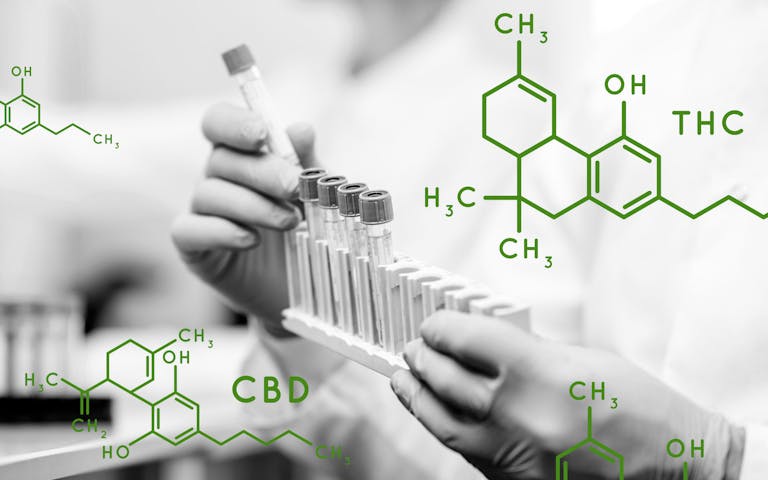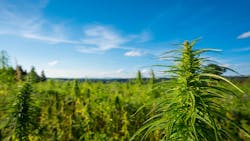SAN FRANCISCO—Gold Seal brand co-founder and grower Neil Dellacava’s jaw dropped when he opened the email and saw the note from his lab: the new batch of his award-winning Gold Seal Cherry Cheesecake flower buds was just 17% THC by dry weight?!
Years worth of tests never had it below the mid-20s. He thought he had his licensed commercial indoor grow dialed in!
This was bad.
“It’s the mark of death,” he explained. “If I have something that’s super-fire that’s 19.1[% THC], that’s borderline. If it was 18 or below, buyers try to negotiate the price down.”
Gold Seal ended up firing its cannabis lab over that stinky 17% THC score. Today, Neil’s happy with the consistent, mid-20s they’re getting from their new lab down in Los Angeles. The new batches of Cherry Cheesecake and Red Congolese are most definitely fire.
“Every lab’s numbers are different. Consistency in THC percentage is the most important thing at this point in time for us,” he said. “We know what these strains are capable of. When a grow room has no changes to it whatsoever and gets a lower score, it’s a concern—especially in a world with consumers being number hunters.”
Five years into state-legal medical and adult use cannabis sales in the US, and it’s almost a mandatory business practice for growers and distributors to shop around for the lab that gives them the highest THC scores.
Excessive test result variance between labs—driven in part by THC potency inflation—remains the original sin of the lab industry. The problem varies in size from state to state, but efforts to standardize and monitor labs have been slow in coming.
“It’s a problem for everybody,” said Leafly scientist Nick Jikomes, who authored a damning paper on lab variance published in the journal Nature in 2018.

- In Washington, lab oversight failure in 2018 preceded lab reporting system collapse this year. Regulators and consumers are “flying blind,” expert Washington data scientist and consultant Jim MacRae told Leafly.
- In Oregon, THC scores peaked at a ludicrous 40% in January amid a scathing state Oregon Health Authority (OHA) audit that found instances of lab shopping and low lab oversight. “Without a mechanism for verifying test results, Oregon’s marijuana testing program cannot ensure that test results are reliable and products are safe,” the OHA audit concluded.
- In California, lab shopping appears endemic. At least a couple labs seem to be inflating THC scores, said Josh Wurzer of SC Labs. Other growers and distributors concurred.
A little ratings fraud might seem harmless—like Shell lying about fuel octane ratings, or McDonald’s going light on the quarter-pounder. But the effects are real.
THC inflation punishes craft growers who can’t pay to twist arms for higher THC scores like the big boys. Consumers are skipping great herb. Bunk scores also jeopardize consumers’ ability to take the right amount, increasing their risk of an accident.
“The devastation really sets in when you know it’s a great strain that’s testing less than 15%, at that point you’re almost dead in the water.”
“The devastation really sets in when you know it’s a great strain that’s testing less than 15%,” said Ben Grambergu, for DYME distribution in Oakland, California. “At that point you’re almost dead in the water.”
Furthermore, some growers and distributors have gone beyond mere lab shopping for THC.
In an era of tougher-than-organic standards, some have begun shopping for passing pesticide results as well, said Swetha Kaul, chief scientific officer at Cannalysis Labs in Santa Ana, California.
Lab Testing’s Original Sin
THC inflation—lying—might be the original sin of cannabis labs.
Consumers started seeing THC scores next to their cannabis in 2012 during the unregulated medical marijuana era in California. Technicians use mass spectrometry, and gas and liquid chromatography, to detect minute amounts of cannabis’ main active ingredient, THC, and other molecules.
State-licensed lab testing for cannabis purity and potency began in Colorado in 2014. Since its inception, consumers preferred high THC scores. The market signal travels up the supply chain to the stores, distributors, growers, and labs. If a lab starts producing low test scores, growers and distributors can switch to a different lab that consistently offers higher ones.
“How the scientist interprets the output and reports the results is up to them.”
Who’s to say who is right? Higher lab results can be accurate, or they can be inaccurate due to error, or sometimes, fraud. The science is so new, every lab can legally come up with their own method for arriving at a THC score.
“The truth is, there is no single guidance that works,” states Marc A. Nascarella, PhD, chief toxicologist at MDPH, and a contributor to the Association of Public Health Labs cannabis guidance stated in 2017. “Cannabis is now being put into oils, resins, food products, suppositories, tinctures, creams, lotions, vape pens and, of course, cigarettes. It is much more than dry flower/plant testing.”
“How the scientist interprets the output and reports the results is up to them,” the OHA 2019 audit states.
Labs are subject to varying levels of accreditation, too. California mandates all labs be ISO certified by end of 2019, but not all are yet. Oregon and Washington do not require ISO certification. Instead, both states hired outside vendors to accredit—not license—labs. The Washington State Liquor and Cannabis Board (WSLCB) doesn’t have a single chemist. Instead, their vendor, RJ Lee, has accredited 13 labs.
California’s Emerging Issues
Lab shopping and THC inflation have dogged California’s market since 2012, but testing quality is looking up in the world’s biggest legal market, where regulators are on the prowl.
Lab numbers will vary by about 3 to 5% THC between labs, growers report. That’s enough to make or break a product launch. (By contrast, a 20% flower that tests between 19 and 21 would be considered a normal variance for the mainstream lab industry, Kaul said.)
“We work with every single lab in the state and we get different results from all of them,” said Christina Dipaci, CEO of The Weed Brand and Paradiso, during the 2018 harvest.
DYME distribution of Oakland said they are choosing not to lab shop right now, even though it may be costing them.
“There are labs we could send our product to and get a higher test result and get a better chance of passing,” said Grambergu. “And can you tell me who is doing it right?”
Josh Wurzer, founder of SC Labs, said customers have switched away from SC after shopping for higher numbers.
“We certainly have clients that are comparing our cannabinoid results against other labs and telling us straight up that they’re making decisions based on cannabinoid results,” he said.
“We have seen one to two labs that are definitely, in comparison to other labs, pumping out really high THC results,” he said.
Kaul, chief scientific officer at Cannanalysis, has seen it, too. “They don’t outright say it, but there’s a lot of times where that’s the understanding.”
Smaller labs may be more subject to pressure, she said. “I’m OK walking away from clients, but if you’re a small startup lab with one client that threatened to walk away, I wouldn’t be surprised.”
Still ‘Flying Blind’ in Washington
Washington is in the process of revoking testing oversight from the state’s Liquor and Cannabis Board. This comes after private citizens busted the state’s biggest lab, Peak Analytics, for inflating THC scores. Straight Line Analytics founder MacRae and others found anomalies in Peak’s state reporting data. For example, Peak tested a Blue Dream flower at 37.1% THC—a statistical near-impossibility.
Peak subsequently failed auditing for microbial testing, the WSLCB suspended their license, and the lab closed. But there’s nothing in Washington’s rules to stop a disgraced lab operator from reopening. Several have.
Plus, a state system update to increase monitoring this summer achieved the opposite, watchers say. The tracking system is down due to bugs in the code.
“Those with oversight of the market are flying blind,” said MacRae. “Consumers in Washington, for the past 18-plus months, have simply had to ‘trust’ the label on their product and the wholesaler that placed it there.”
“I would fully expect that lab shopping, THC inflation, passing tainted products, or skipping purity tests is not an uncommon occurrence in Washington today,” he said.
Oregon Hits Rock Bottom
In Oregon, state auditors issued a scathing January report on lab oversight failures, including lack of inspections and evidence of lab shopping. Twelve of the state’s 22 labs hadn’t been inspected, “a critical and requiredcomponent of the accreditation process,” the audit states.
The audit didn’t mince words. “Limited authority, inadequate staffing, and inefficient processes reduce OHA’s ability to ensure Oregon marijuana labs consistently operate under accreditation standards and industry pressures may affect lab practices and the accuracy of results.”
The audit also found behavior that looked like lab shopping, as “43% of processors used three or more labs between January 2017 and July 2018. During the same period, 38 growers and processors used five or more labs, and one processor used nine separate labs.”
Wurzer concluded “Oregon is a mess,” though lab accuracy may have improved slightly this year.
Kaul—who also operates an Oregon lab—said Oregon’s rules are good, but regulators are just overwhelmed and not checking up on labs enough.
By contrast, Colorado’s small, five-lab industry seems to have far fewer problems.
Jikomes said, “In general, I think states with more licenses have a worse problem. Places like Oregon and Nevada seem to be the worst in terms of lab shopping and THC inflation, because there are lots of labs, lots of stores, and therefore regulatory oversight is that much more diluted.”
Beyond THC: Shopping for CBD and Pesticide Results
Growers and distributors are lab shopping for more than high THC scores. Some appear to be shopping for passing grades for pesticides, which is much more worrisome.
California’s cleaner-than-organic rules have bit down hard on growers. 20% of batches failed for pesticides when action limits kicked in Jan. 1, 2019. By July, just 5-6% of batches failed for pesticides. Kaul thinks normal pesticide fail rates should be around 9-10% of all batches.
Either California growers have really cleaned up their act, or they’re finding a way to pass dirty product, Kaul said. Customers have told her they use competing labs to pass pesticides screens they would otherwise fail at Cannalysis.

(Leafly)
“Padding THC scores, it’s annoying. But releasing pesticides into the market—that’s worrying,” Kaul said.
By contrast, Wurzer has not seen lab shopping for passing pesticide scores. “If they want to cheat at a safety test, I don’t want them as a customer.”
Both Kaul and Wurzer see this behavior as a relic of the Wild West medical marijuana days—where you got product to market by hook or by crook.
How to End Lab Shopping, THC Inflation
At this point, tougher rules, oversight, and a cultural evolution are the most promising strategies to end lab shopping and THC inflation. It’s just a matter of how fast they can be implemented.
Accreditation
Cannabis lab testing isn’t the dark art it was seven years ago. “Over the years the methods have started to solidify,” said Kaul.
Labs should be required to get accredited to ISO standards, said Jikomes. That involves on-site inspections and peer review. It’s a global standard that’s free to the state.
“Participating labs would conduct tests on each other several times a year, and if a lab’s results are too far off from the rest, they would lose their accreditation,” he argued.
Ongoing ISO mandates in California “will help a lot. You’ll see the cream rise to the top,” said Wurzer. SC Labs has two ISO certifications.
Auditing
There’s no substitute for good old-fashioned inspections and auditing. For example, Oregon lab staffers have no background check requirements. “Apart from an estimate of staff numbers, not much is known about who is employed at Oregon marijuana labs,” the OHA audit concluded.
California needs to standardize lab data tracking and automate auditing for anomalies. When everyone is reporting all analytes from all batches, norms and outliers emerge. That’s how Peak Analytics in Washington got caught.
“You can easily see if one lab is way out of the statistical norm,” Wurzer.
For example, Wurzer reports maybe one out of 100 flower samples is testing at 30% THC these days. “It’s not impossible,” he said. “It should be extremely rare. We’ve definitely seen some legit samples over 30%.”
But if a lab constantly spits out 30-plus% THC scores, then that’s a red flag, he said. “It’s when you look at total overall output—you can see who is pulling a fast one or not.”
Wurzer suspects THC inflation in California “won’t last long. The BCC will catch wind of it. They’re looking at the data and when they get evidence of either bad practices or out-and-out tomfoolery they’ve been quick to react.”
The oversight of legalization is taming California labs, said Wurzer. “In general, you’re getting good testing in California. I think it’s getting better.”
Self-Policing
Competing labs hate it when peers cheat. It undercuts their business, and they’ll turn you in. The Cannabis Lab Alliance helped level Peak Analytics in Washington. Labs in emerging markets can volunteer for ring tests where every lab measures the same sample (passing it around in a ring) and outliers improve their methods.
Wurzer relates an example. “I’m looking at a concentrate they sent to four labs: [the THC results were] 84%, 83%, 85%, and then 99%.” Wurzer laughs. “OK, the BCC is going to catch that. Or the other labs you pissed off that you’re cheating are going to point that out to the BCC and they’ll take action.”
Consumers Must Get Wise, Trust Senses Over Scores
While oversight kicks in, consumers can do their part to move beyond THC scores. They’re not the true quality indicator for cannabis.
“The way you solve this is with the culture,” said Kaul.
“You don’t choose wine based on alcohol content, you choose it on taste and flavor,” Wurzer said. “I’m much more interested in the flavor of it and the experiences, and if I wanted to be a little higher I’d hold it in.”
Kaul said consumers need to start trusting their senses. Is it terpene-rich? Do the trichome heads look full and fresh? Does it feel like your jam?
Judges at the industry’s most prestigious cannabis competition, The Emerald Cup, will tell you the highest THC flower never wins. The terpenes radically shape the effects of THC.
“In terms of flower, the connoisseur is often not looking at potency at all,” said Grambergu. “Nose and eyes are what we judge by. It’s majority the budget, economy, new smoker that is tying THC percentage to price point and deriving value.”
Grambergu said the best cannabis he’s smoked this year was 16.8% THC, and he didn’t notice till he threw the jar away.
“The only thing 30% means to me anymore is that the consumer wants it,” he said. “It has almost nothing to do with the actual effect.”.
Ultimately, chasing THC is comical, since most THC is burned or exhaled anyway.
“The consumer just doesn’t understand,” Wurzer said. “If it’s 30% THC or 10%, if you’re going to roll it into a joint you’re inhaling, then 80-90% of the cannabis’ THC is gone in every breath.”
[Middle photo: Gold Seal Cherry Cheesecake, by David Downs for Leafly]





